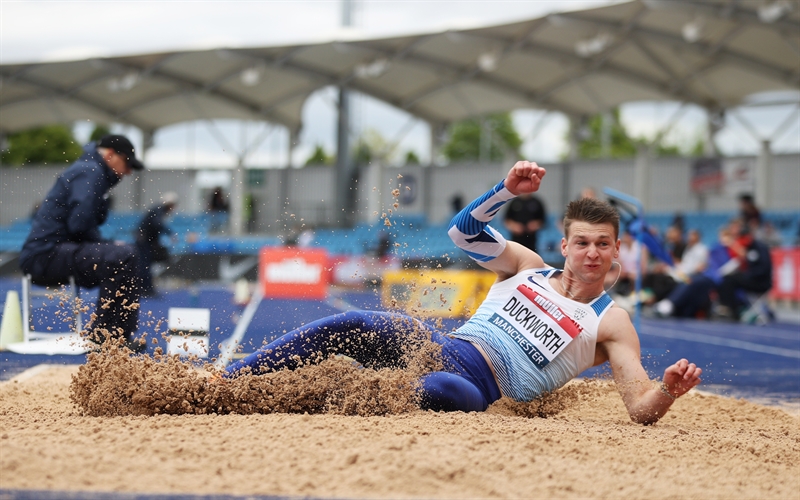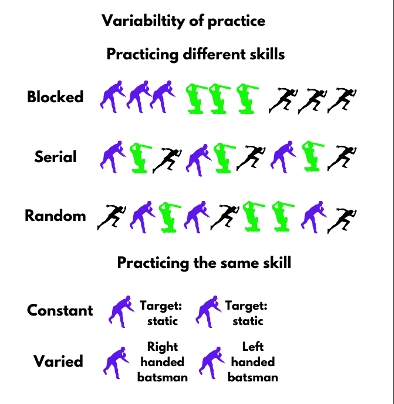You are viewing 1 of your 1 free articles
State of mind: understanding cognitive load in performance and injury rehabilitation
What makes an athlete’s motor skills fail when they need them most? Jason Tee investigates this phenomenon and reveals surprising and important implications for performance, injury prevention, and rehabilitation.

Athletics - British Athletics Championships - Manchester Regional Arena, Manchester, Britain - June 25, 2021 Britain’s Tim Duckworth in action during the men’s Decathlon Long Jump Action Images via Reuters/Molly Darlington
In the 1993 Wimbledon women’s final, Croatian sensation Jana Novotna led Steffi Graf 6-7, 6-1, 4-1, and required a single service point to go into a commanding 5-1 lead in the deciding set. Winning Wimbledon would be the biggest achievement of her career and propel her to tennis stardom. Then, inexplicably, Novotna double-faulted and lost the title.
In another example of a clutch moment gone wrong, long jumper Shi Yuhao had one last jump and an opportunity to score a dramatic win in a 2018 competition. He attacked his run-up with a fury, but something went wrong in his take-off stride, and instead of sailing to victory, he lay in the sandpit, clutching his ankle. Is there a link between these two accounts of failed performance?
Working memory versus long-term memory
Cognitive psychologists suggest that motor skill learning has three components (see figure 1) (1):
1.Sensory perception
Humans have limited perceptive bandwidth and can only focus on a few sensory inputs at once. For example, think about how people stop hearing a song playing in the background to listen to an interesting conversation. Therefore, the first step in any learning process is the perception of a stimulus. To learn a motor skill, you must attend to the appropriate input (e.g., watching a coach’s demonstration). We immediately forget a sensory input if we ignore it.
2.Working (short-term) memory
Humans also have limited attentional capacity. Most can only keep five to seven items in their short-term memory before forgetting one of the items. This limitation makes learning multi-step motor skills difficult.
3.Long-term memory
Despite the failings described above, humans do have the ability to encode information in long-term memory permanently. This capacity is theoretically unlimited, and once encoded, the access and use of long-term knowledge and skills are almost effortless. For example, skills such as walking are encoded in long-term memory and require no cognitive effort.
Figure 1: Components of motor skill learning.

Learning, retaining, and using motor skills
There are three distinct stages of learning in motor skill literature. Researchers describe them as cognitive, associative, and autonomous (see table 1). When highly skilled individuals perform, their movements make kinaesthetic sense. Years of deliberate practice make their actions coordinated, logical, and efficient. Importantly, they have rehearsed these movements to the point that they are autonomous, thus freeing up working memory to attend to other aspects of performance.
| Stage of motor learning | Movement characteristics | Attentional demands |
|---|---|---|
| Cognitive | Initial stages of motor learning. | Considerable demand on working memory. Participants focus on what body parts to move and how. |
| Movements are slow, inconsistent, and inefficient. | Fine motor control is largely absent. | |
| Associative | Intermediary stage of motor learning. | Less cognitive activity is required, and reduced demand on working memory. |
| Movements become more fluid, reliable, and efficient. | Gross motor patterns have been committed to long-term memory, allowing increased focus on fine motor control. | |
| Autonomous | Final stage of motor learning. | Little or no cognitive activity is required. |
| Movements are accurate, consistent, and efficient. | Gross and fine movement patterns have been committed to long-term memory and can be accessed with minimum effort. |
Effects of cognitive load on skilled performance
Unlearned skills require a significant contribution from the working memory. In chaotic environments where many factors compete for attentional focus, working memory quickly becomes overloaded and leads to reduced performance. Therefore, when learning a new task, one usually reduces attentional demands to focus (e.g., turning off the car radio when lost in an unfamiliar neighborhood). Unfortunately, in many contexts, athletes can’t simply turn off distractions. The stress of competitive environments amplifies the difficulty of skilled performance. It takes many hours of additional practice before performers can transfer what they do in training onto the competitive stage.
Cognitive and emotional fatigue also affect working memory capacity. For example, athletic performance usually suffers when athletes perceive a task as more difficult or demanding(3). Therefore, when athletes experience emotional and cognitive fatigue, clinicians should adjust the expectations of their ability to learn new skills and demonstrate motor learning.
‘Choking’ in sport
‘Choking’ in sport is defined “as the substandard performance in pressure situations despite superb skills and individual strivings for best performance(4).” Athletes spend hundreds of hours practicing for high-pressure situations. As a result, they have a reasonable expectation of success when that moment arises. However, there are countless examples of high-profile athletes who commit skill errors when the game is on the line.
There are two predominant theories regarding why choking occurs: the distraction model and the self-focus model(5).Both these mechanisms may cause choking at different times or simultaneously. The example of choking in sport illustrates how cognitive load may affect skilled performance.
1.The distraction model
This model suggests that attention shifts from task-relevant information (e.g., watching the ball closely) to irrelevant details (e.g., the crowd’s noise) due to heightened anxiety.
2.The self-focus model
Athletes display highly skilled and autonomous movements that do not require conscious control. However, in stressful situations, or when athletes are highly motivated, they may focus so hard on their skill execution that they allocate conscious attention to what should be an autonomous task, regressing the skill execution to an associative or cognitive movement.
Cognitive load in injury prevention and rehabilitation
Understanding how cognitive load affects performance has a range of applications for injury prevention and rehabilitation. When athletes are highly motivated or involved in high-stakes competition, their movement quality may suffer, increasing their injury risk. Some strategies may help mitigate these risks:
- Ensure that training is representative of the competition environment. In this way, the athlete can practice focusing on task-relevant information.
- Use visualization and mental rehearsal – Although it will never be possible to replicate the competitive environment during rehabilitation and return-to-play training, athletes may be able to do so in mental rehearsals. Using visualization, athletes can practice high-pressure situations and make decisions about cognitive coping strategies.
- Practice pre-performance routines or rehearsed sequences of thoughts and actions performed before executing a specific sport skill (e.g., repeating a mantra or bouncing the ball three times before serving).
Practical implications
In the rehabilitation setting, athletes often adopt dysfunctional or sub-optimal movement patterns due to decreased strength, range of movement or pain. The clinician’s role is to teach athletes alternative movement patterns. Understanding cognitive psychology can aid in transferring these skills to strategies that athletes will use in game situations.
Cognitive psychology defines performance as “temporary improvements in knowledge, skill or behavior that are observed during or immediately after practice or instruction(6).” On the other hand, learning is a relatively permanent change in knowledge, skill, or behavior(6). Thus, performance changes are short-lived and quickly forgotten, while learning a skill means an athlete can access it in different contexts and after long periods (e.g., riding a bicycle).
The challenge for clinicians is that certain instructional styles promote performance and reduce learning. Athletes may improve motor skills quickly in predictable, repetitive practice routines, but their retention and the ability to transfer them to other environments is typically low. For example, when athletes practice motor skills (like jump landings) perfectly in the clinic environment, they often revert to poor technique when re-joining their sports practice. On the other hand, chaotic, unpredictable practices look ineffective because the performance is poor. However, under these conditions, the retention and transfer of skills improve(6).
Physios may think they are teaching new motor patterns; however, most rehabilitation protocols progress when an athlete meets performance goals. In addition, the lack of real motor learning may contribute to the high rates of repeated injury, such as in ACL injuries. To promote motor skill learning in rehabilitation, clinicians should incorporate these techniques:
- Variable practice – When training for a return to play after injury, incorporate variability and unpredictability into rehabilitation activities as early as possible. Vary how and when the athlete uses the skill (see figure 2). Requiring attentional focus to determine the correct movement solution for each challenge helps commit the skill to long-term memory.
- Spacing practice – Revisit previously learned motor skills so that the athlete has to remember the movement pattern. Trying to remember something recently learned but not recently practiced helps convert the movement pattern to long-term memory.
- Control to chaos – Athletes should return to training before returning to play. Competitive play requires athletes to react to their opponents and game status, leaving little time to plan movement patterns. However, training offers a chaotic environment similar to competition, while physios and trainers control the play situations. Reproduce this in the clinic by performing group activities, playing loud music, or practicing on different surfaces. This helps athletes store movement patterns in their long-term memory (see figure 2). Continually altering training parameters leads to greater skill retention when compared to constant, unchanging practice(7).
Figure 2: Variability of practice

References
- Information processing and memory: Theory and applications. 2003
- Edwards, William H. Motor Learning and Control: From Theory to Practice. Belmont, CA: Wadsworth Cengage Learning, 2010. Print.
- Med Sci Sports Exerc. 2016 Feb;48(2):267-76.
- J Personal. Soc Psychol. 1984; 46(3): 610–620
- Int Rev of Sport and Exerc Psychol. 2019 Jan;12(1):176-201.
- Perspect Psychol Sci. 2015 Mar;10(2):176-99.
- Br J Sports Med. 2019 Sep;53(18):1132-1136.
Related Files
Newsletter Sign Up
Subscriber Testimonials
Dr. Alexandra Fandetti-Robin, Back & Body Chiropractic
Elspeth Cowell MSCh DpodM SRCh HCPC reg
William Hunter, Nuffield Health
Newsletter Sign Up
Coaches Testimonials
Dr. Alexandra Fandetti-Robin, Back & Body Chiropractic
Elspeth Cowell MSCh DpodM SRCh HCPC reg
William Hunter, Nuffield Health
Be at the leading edge of sports injury management
Our international team of qualified experts (see above) spend hours poring over scores of technical journals and medical papers that even the most interested professionals don't have time to read.
For 17 years, we've helped hard-working physiotherapists and sports professionals like you, overwhelmed by the vast amount of new research, bring science to their treatment. Sports Injury Bulletin is the ideal resource for practitioners too busy to cull through all the monthly journals to find meaningful and applicable studies.
*includes 3 coaching manuals
Get Inspired
All the latest techniques and approaches
Sports Injury Bulletin brings together a worldwide panel of experts – including physiotherapists, doctors, researchers and sports scientists. Together we deliver everything you need to help your clients avoid – or recover as quickly as possible from – injuries.
We strip away the scientific jargon and deliver you easy-to-follow training exercises, nutrition tips, psychological strategies and recovery programmes and exercises in plain English.










